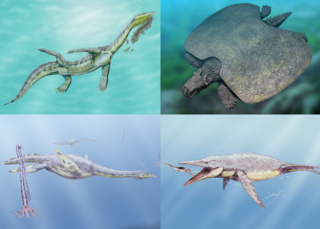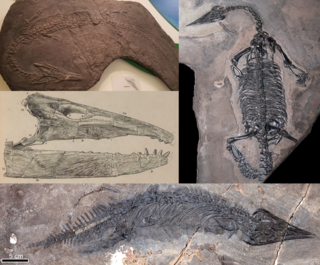
Marine reptiles are reptiles which have become secondarily adapted for an aquatic or semiaquatic life in a marine environment. Only about 100 of the 12,000 extant reptile species and subspecies are classed as marine reptiles, including marine iguanas, sea snakes, sea turtles, and saltwater crocodiles.

Sauropterygia is an extinct taxon of diverse, aquatic reptiles that developed from terrestrial ancestors soon after the end-Permian extinction and flourished during the Triassic before all except for the Plesiosauria became extinct at the end of that period. The plesiosaurs would continue to diversify until the end of the Mesozoic. Sauropterygians are united by a radical adaptation of their pectoral girdle, adapted to support powerful flipper strokes. Some later sauropterygians, such as the pliosaurs, developed a similar mechanism in their pelvis.

Sea snakes, or coral reef snakes, are elapid snakes that inhabit marine environments for most or all of their lives. They belong to two subfamilies, Hydrophiinae and Laticaudinae. Hydrophiinae also includes Australasian terrestrial snakes, whereas Laticaudinae only includes the sea kraits (Laticauda), of which three species are found exclusively in freshwater. If these three freshwater species are excluded, there are 69 species of sea snakes divided between seven genera.

Thalattosauria is an extinct order of prehistoric marine reptiles that lived in the Middle to Late Triassic. Thalattosaurs were diverse in size and shape, and are divided into two superfamilies: Askeptosauroidea and Thalattosauroidea. Askeptosauroids were endemic to the Tethys Ocean, their fossils have been found in Europe and China, and they were likely semiaquatic fish eaters with straight snouts and decent terrestrial abilities. Thalattosauroids were more specialized for aquatic life and most had unusual downturned snouts and crushing dentition. Thalattosauroids lived along the coasts of both Panthalassa and the Tethys Ocean, and were most diverse in China and western North America. The largest species of thalattosaurs grew to over 4 meters (13 feet) in length, including a long, flattened tail utilized in underwater propulsion. Although thalattosaurs bore a superficial resemblance to lizards, their exact relationships are unresolved. They are widely accepted as diapsids, but experts have variously placed them on the reptile family tree among Lepidosauromorpha, Archosauromorpha, ichthyosaurs, and/or other marine reptiles.

The extant (living) reptiles of New Zealand consist of numerous species of terrestrial lizards and the lizard-like tuatara, and several species of sea turtles and sea snakes. All but one species are native to New Zealand, and all but one of the terrestrial species are endemic to New Zealand, that is, they are not found in any other country. Many species of foreign reptiles enter New Zealand through accidental importation or smuggling, but only the Australian native Lampropholis delicata has become established in the wild, and it is considered an invasive pest.

Vladimir Yemelyanovich Kharin (1957–2013) was a Russian zoologist, ichthyologist, herpetologist, and a specialist in sea snakes.





